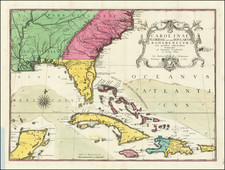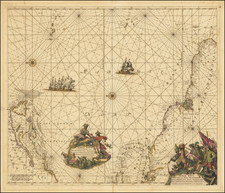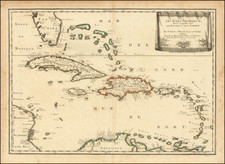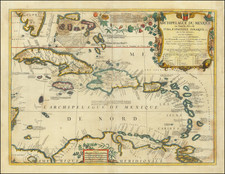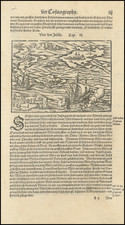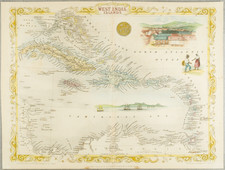A fine hand-colored engraved view of the Spanish surrendering Havana to the British in 1762, executed by the greatest maritime painter of the 18th century, Dominic Serres.
The present view was part of a series of twelve taken on the spot by Philip Orsbridge. He was a lieutenant on HMS Orford at the capture of Havana. Upon returning to London, he decided to capitalize on the popular appreciation of the victory and have his views published as a set of engravings. In this, he was following the example of Richard Short, whose set of prints commemorate Wolf's campaign in Quebec, in 1759, also during the French and Indian War. Orsbridge commissioned Short's team to produce the finished drawings and engravings. Dominic Serres made the paintings and Canot and Mason produced the plates.
The engraving is of the highest quality; the skill of the artists is particularly evident in the diverse and elaborate typography below the image. The rendering of the clouds and ships is quite remarkable. A key in the lower left elaborates the ships and the complement of guns aboard. The engraver is James Mason.
Sir George Pocock (1706-1792) was a British naval officer of considerable consequence during the Seven Years War. His crowning achievement was the capture of Havana in 1762, as a result he became very rich, however, he was passed over for the Admiralty Board in spite of his success, and, as a result, he resigned his commission in 1766.
George Keppel, 3rd Earl of Albemarle (1724-1772) was a British soldier and nobleman who is best known for the feat depicted in Serres set of engravings -- the capture of Havana in 1762.
The "secret expedition" to capture Havana set off from Spithead on March 5, 1762. By the 26th of April, it had arrived in Martinique, pausing there before setting off again on May 6. The flotilla landed troops six miles east of Havana on June 7 and siege-works were started upon at once. The army was aided by a large number of seamen who helped land canon, man the batteries, and supply the troops with water. The British had received detailed reports of the weak points in Havana's defenses provided by the Governor of Jamaica, Admiral Knowles. By the 30th of June, the batteries were ready, and they opened fire on the July 1. Three ships of the line engaged from the water, but two of them left action after heavy losses six hours into the battle. Eventually, the land batteries subdued the Spanish defense, and on the 30th of July, the Moro was stormed. The city capitulated on August 13. The prize money was considerable, netting Pocock over £122,000 alone.









